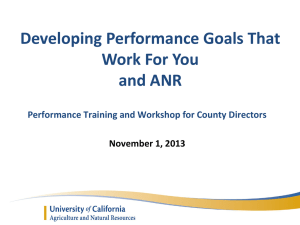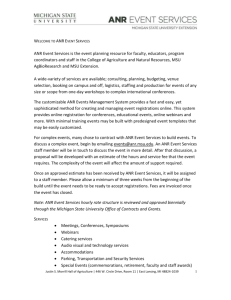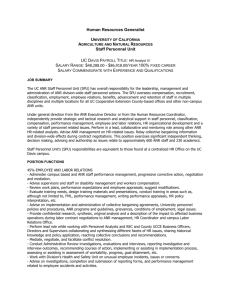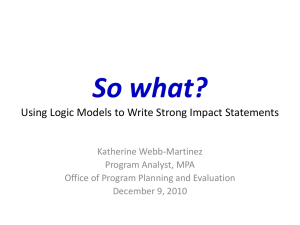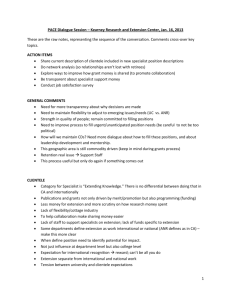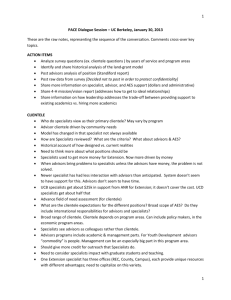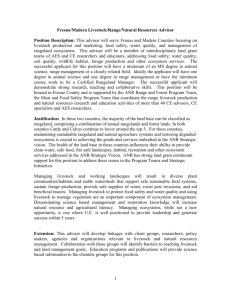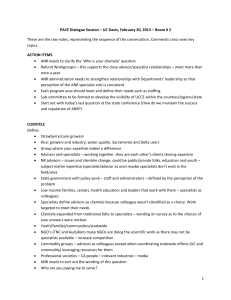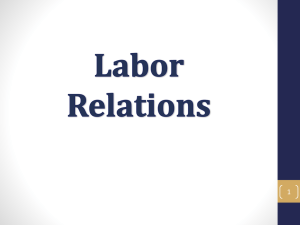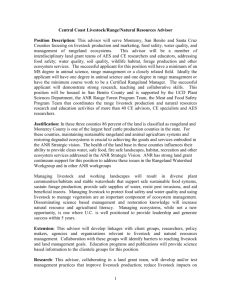UC Davis Room 3 Recorded Comments
advertisement
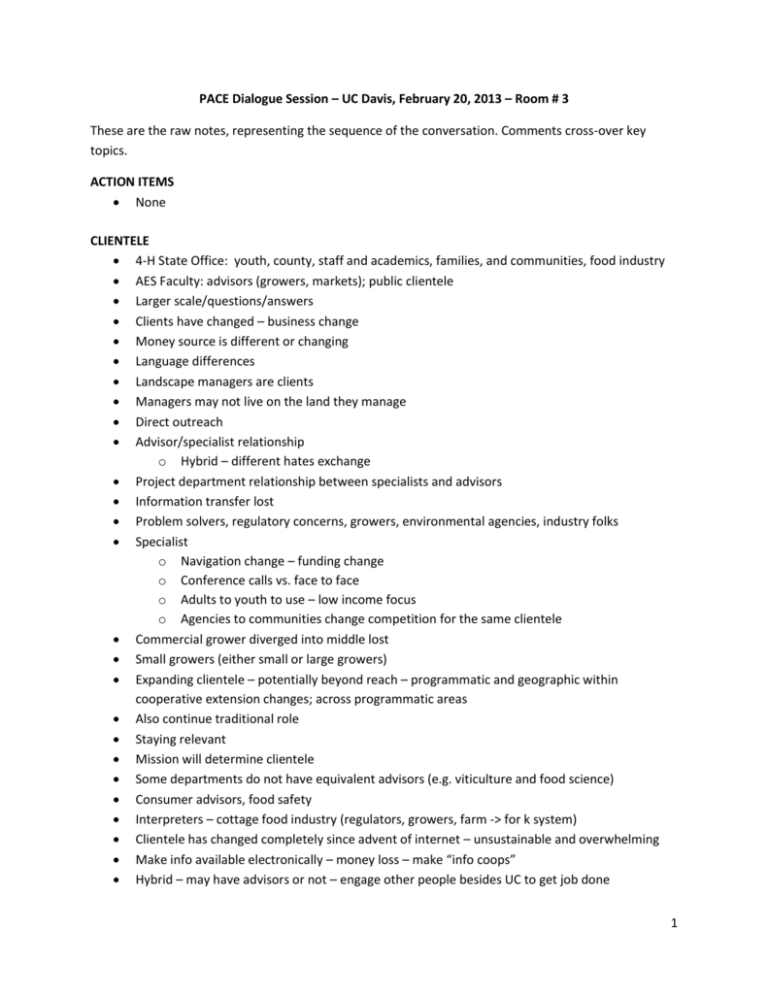
PACE Dialogue Session – UC Davis, February 20, 2013 – Room # 3 These are the raw notes, representing the sequence of the conversation. Comments cross-over key topics. ACTION ITEMS None CLIENTELE 4-H State Office: youth, county, staff and academics, families, and communities, food industry AES Faculty: advisors (growers, markets); public clientele Larger scale/questions/answers Clients have changed – business change Money source is different or changing Language differences Landscape managers are clients Managers may not live on the land they manage Direct outreach Advisor/specialist relationship o Hybrid – different hates exchange Project department relationship between specialists and advisors Information transfer lost Problem solvers, regulatory concerns, growers, environmental agencies, industry folks Specialist o Navigation change – funding change o Conference calls vs. face to face o Adults to youth to use – low income focus o Agencies to communities change competition for the same clientele Commercial grower diverged into middle lost Small growers (either small or large growers) Expanding clientele – potentially beyond reach – programmatic and geographic within cooperative extension changes; across programmatic areas Also continue traditional role Staying relevant Mission will determine clientele Some departments do not have equivalent advisors (e.g. viticulture and food science) Consumer advisors, food safety Interpreters – cottage food industry (regulators, growers, farm -> for k system) Clientele has changed completely since advent of internet – unsustainable and overwhelming Make info available electronically – money loss – make “info coops” Hybrid – may have advisors or not – engage other people besides UC to get job done 1 Info delivery varies depending on educational level Information competition – funding – competition Wide sharing of information not always documented in presentation Media outreach Increase university visibility Better web portals for information share Better branding, develop apps – use modern technology – on site Expanding expectations ANR need to be more active and innovative Private companies, USDA (competitors of ANR) are better funded ROLES AND RESPONSIBILITIES Seek and acquire funding is prime responsibility Developed research based info for education programs Difficult to keep active and good relationships with expending community clientele. Balance with internet-based and face to face meeting Advisors need to develop research based info and save clientele –especially if they are not directly associated with specialists Funding crucial to bring all the clients and people together Grants take too much time – baseline funding very important. Grant dependency is not good funding. Baseline IPM allows time to do research without having to take time to apply for grants o Does not take a lot of money, maybe 2k to allow for this Grant writers within ANR needed Joint projects o Campus to county funding is larger amount Identify need – identify the right people to write for the grants – instead of individual pursuits Travel support needed Time investment for collaboration does necessarily come to fruition. Needs to be worth the time spent. Support what we do best. Large grants for a few does not support work of advisors. Any relationships not funding dependent? More FTEs needed – expand number of advisors – core funding in place o FTEs – on ground to deliver the programs More important for more WG meetings Narrowing focus – broader horizon with internet – complicated Teaching more – more internal TRAVEL – must be able to visit with advisors funding for travel needs increased budget. Meeting with collaborators particularly important in CA Materials – development cut into advisor/FTEs etc. Include in grant money 2 o More time spent prioritizing projects/client requests Time needs to be built into grant Grant deliverables o Advisor position – 4H families and nutrition Travel time between counties is huge – time consuming Broad topic, subject area expertise – multicounty Advisor/specialists – strong administrative skills – creativity and research. Identify expertise areas maybe not at level of rolling out the program substantial time. Advisors becoming more like specialists – is this really possible? Peer reviewed publications o Current system set up when funding was available but no longer available to address communities’ needs. Mission impossible roles o New job descriptions – who can possibly do these well? Human Concern o ANR can’t be all things to all people o ANR must allow people to do well what they do well Not take everyone down to a level COLLABORATION Outdated approach, direction within ANR. Outdated because no budget for workgroups – what was 1-degree mechanism for collaboration No directors; and faculty and specialist treated equally in terms of funding Provide opportunities, such as workgroups, for meaningful collaborative (AES faculty and specialist/advisors ) and mentoring needs $$ (even small budgets) Why were workgroups defunded? Move to SI has fractured tie between AES faced and CE and means to leverage additional fund opportunities Collaboration projects with colleagues without funding (funding would facilitate such activity) Programs fit into SI even before SI created. Diverted focus from existing practice. Today’s management not ideal environment to foster collaboration SI are too broad to have useful focus to foster collaboration ANR SI vision was to have fewer focus points (in its original concept) Now we have more areas of focus Vision implementation may not have worked as intended – and maybe not as inclusive Workgroups were more inclusive ANR examined process o Did it focus? County was already adding issues and just needed funded arena. ANR took away structured that was working and took money -> to SI Grants o ANR grant review needs to change – call for 5% over what ANR will Actually fund 3 Better use of IT – content – credit needs to be given in larger collective tied to merits and promotions Address collective site -> credits or websites Review policies and practice barriers to collaboration Transfer grant money – is time consuming, barriers in transferring money within UC system (UC to county) Limited collaboration between AES faculty and advisors, specialists Invite faculty speakers – lost link and give them a role – worked in past. Are not part of ANR. Existing coalition foster collaboration between AES faculty, advisor and specialist Content related collaborations – across subset areas, need a natural connection Silos still exist Collaboration across disciplinary programs tied to merits and promotions. System is not taking advantage of this Metrics to monitor programs long term o high impact long term projects – review them for program toward long term goals (How it’s tracked) PROGRAM PLANNING Fewer people – less collaboration – opportunities even within counties Who will validate promotions and who are they tied to? Of specialists outside departments. If we take specialists out of depts. – potential for isolation. Potential not to develop fully as an academic How is this different for advisors in the counties – not in depts. Either Generator of research based materials not linked to specific – Academic University Association Water model LAWR successful with specialists located in county and county access to specialist – also linked to dept Link to academic dept council for specialist Double funded needed today for new specialists 150-300k for successful programs (outside of dept) county may not be able to host Specialists within departments not always working with counties Advisors unaware of promotion process of specialists within departments and accountability to counties/CE ANR $ -> specialists – in many cases specialists are involved in individual pursuit rather than working in ANR advisor lower priority Is ANR not providing any funding specialists so they can work? On Strategic Initiative Only ANR Program Planning is around who they are hiring for specialists positions and nothing else ANR has no budget and they can plan nothing 4 ANR fosters less program planning than departments and not pretending to direct faculty Campus based specialists more open to marginalized areas than if posted off site somewhere and not avail to advisors Dept expectation specialists – some specialists highly regarded in field/dept. dept differences Establish office work space in new ANR building for specialists when they come to have meeting with us. Make place available –“ their office feel” Perceived value of specialists in county – but may not be offset by negatives. Regional specialists NOT statewide. (Central location can be an advantage. Specialists located close to program is an advantage.) Enriches program can initiate projects with central location. Industry to bury own specialists is detrimental to ANR – we need to think about this affects who applies and who is hired o “Funder Voice” in hiring process Is there a distinction between a county based advisor with PHd and a specialist who is regional Workgroups – See collaboration notes on topics ANR must work with industry – not just to fund specific positions. Lab and facility support (e.g. streets of Washington – dangerous position) OPEN TOPIC External people don’t care about all the micro managed logos – we just need a collective broad branding and easy to recognize as UC Stop changing the ANR brand o Not fair to clientele to figure “out who we are now” o Not working for clientele, UC is preferred o Information overload – another reason to keep UC Campus-based youth programs and not done as 4H programs, UCOP, EFNEP, Master Garden ANR needs to brand actual program, UC 4H work, e.g. Brand as ANR Youth Development – why is UCD doing camps and let us (4H) do what we’ve been doing for years Take advantage of our resources Paranoia – ANR trying to separate from departments and we need to foster collaboration and funding Foster interaction o Coop AES – focus on all Turf issue o ANR structure – ANR coop credit Rethink ANR completely – worked in past when there was funding Piece of the mission to various campus ANR wants to be separate. Seem to cut UN recognition County Director Field Job Concept at 1 FTE (Full time position) Don’t pay at 1/3 FTE for full time Admin lost move all the way up; still spending the money Less advisors – but work is still there 5 MEETING EVALUATION What Worked Well? + Facilitator Discipline/program mix What Would make It Better? ++ Too large of a small group Regroup into larger group to summarize with top admin. present Will any real change response result from this process? Include top admin (not included to allow open forum) Barbara Allen-Diaz and Bill Frost present to ANR Statewide Conference 40% non-response to PACE survey so what has been lost Survey wording didn’t fit with desired input PACE survey sent at same time as other survey was so confusing 6
